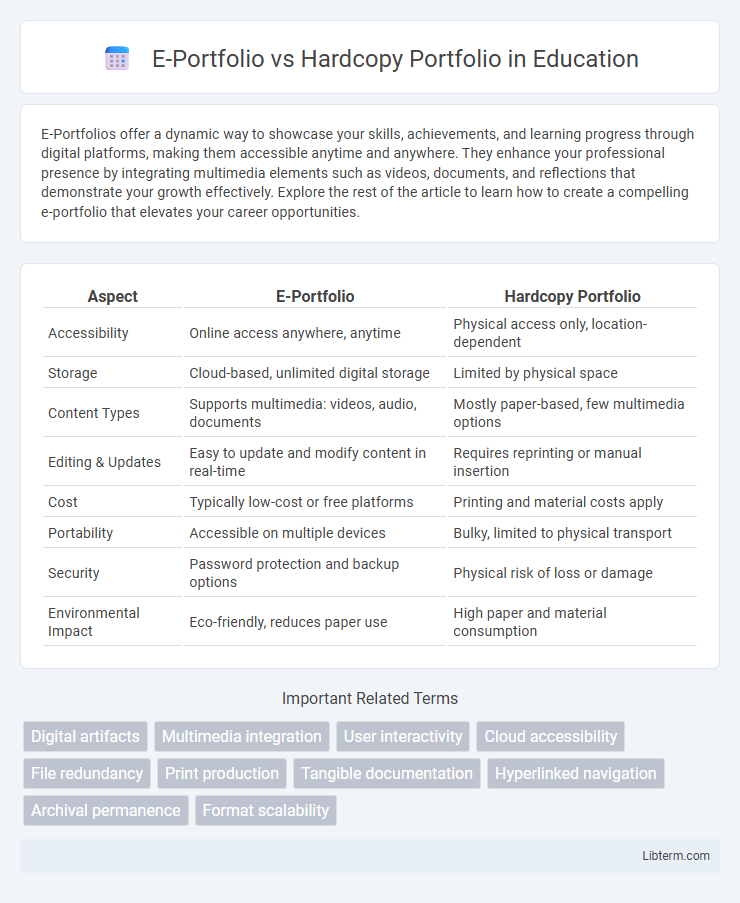E-Portfolios offer a dynamic way to showcase your skills, achievements, and learning progress through digital platforms, making them accessible anytime and anywhere. They enhance your professional presence by integrating multimedia elements such as videos, documents, and reflections that demonstrate your growth effectively. Explore the rest of the article to learn how to create a compelling e-portfolio that elevates your career opportunities.
Table of Comparison
| Aspect | E-Portfolio | Hardcopy Portfolio |
|---|---|---|
| Accessibility | Online access anywhere, anytime | Physical access only, location-dependent |
| Storage | Cloud-based, unlimited digital storage | Limited by physical space |
| Content Types | Supports multimedia: videos, audio, documents | Mostly paper-based, few multimedia options |
| Editing & Updates | Easy to update and modify content in real-time | Requires reprinting or manual insertion |
| Cost | Typically low-cost or free platforms | Printing and material costs apply |
| Portability | Accessible on multiple devices | Bulky, limited to physical transport |
| Security | Password protection and backup options | Physical risk of loss or damage |
| Environmental Impact | Eco-friendly, reduces paper use | High paper and material consumption |
Introduction to E-Portfolios and Hardcopy Portfolios
E-portfolios offer dynamic, multimedia presentations of skills and achievements accessible online, enhancing portability and ease of updating compared to traditional hardcopy portfolios. Hardcopy portfolios provide a tangible collection of work, favored for face-to-face interviews and professional settings where physical documentation is preferred. Both serve to showcase personal and professional development, but e-portfolios leverage digital tools to enable interactive content and instant sharing.
Key Differences Between E-Portfolios and Hardcopy Portfolios
E-portfolios offer dynamic multimedia integration, allowing users to embed videos, audio, hyperlinks, and interactive elements, whereas hardcopy portfolios are limited to static printed materials. E-portfolios enable easy updates and instant sharing via digital platforms, contrasting with the physical, tangible nature of hardcopy portfolios that require manual distribution. Storage and accessibility favor e-portfolios due to cloud-based solutions, while hardcopy portfolios necessitate physical space and can be cumbersome to transport.
Advantages of E-Portfolios
E-portfolios offer enhanced accessibility, allowing users to showcase work anytime and anywhere through digital devices, unlike hardcopy portfolios limited by physical presence. They enable easy updates and multimedia integration, such as videos and hyperlinks, providing a dynamic and interactive presentation. Furthermore, e-portfolios facilitate efficient sharing and collaboration, supporting online evaluations and broader audience reach without the constraints of traditional paper documentation.
Advantages of Hardcopy Portfolios
Hardcopy portfolios offer tangible interaction, allowing evaluators to physically browse through materials, which can create a memorable impression. They do not rely on technology or internet access, ensuring consistent presentation quality in any setting. Physical portfolios also provide a straightforward way to showcase artwork, printed photographs, or textured materials that digital formats may not capture effectively.
Challenges of Using E-Portfolios
E-portfolios face challenges such as technological barriers, including inconsistent access to reliable internet and software compatibility issues, which hinder their usability across diverse user groups. Data security and privacy concerns pose risks as sensitive information stored digitally can be vulnerable to unauthorized access or breaches. Furthermore, the learning curve associated with digital tools can disadvantage users who lack adequate technical skills or training, limiting the effectiveness of e-portfolio implementation.
Limitations of Hardcopy Portfolios
Hardcopy portfolios are limited by their physical nature, restricting easy sharing and accessibility, especially in remote or digital environments. They are vulnerable to damage, loss, and deterioration over time, which can compromise the quality and longevity of showcased work. The inability to incorporate multimedia elements reduces the dynamic presentation of skills and achievements compared to the interactive capabilities of e-portfolios.
Accessibility and Portability Comparison
E-portfolios offer superior accessibility by allowing users to showcase their work anytime and anywhere via internet-connected devices, eliminating geographical and time constraints. Their portability is unmatched, as digital files can be easily stored, shared, and updated on cloud platforms without the bulk and physical limitations of hardcopy portfolios. Conversely, hardcopy portfolios lack instant accessibility and are cumbersome to transport, making e-portfolios a more efficient and flexible option for modern professionals and students.
Security and Privacy Concerns
E-portfolios offer enhanced security features such as encrypted access and password protection, reducing risks of unauthorized viewing compared to hardcopy portfolios that can be physically lost or stolen. Digital platforms enable controlled sharing and easy updating, minimizing privacy breaches related to outdated information or misplaced documents. However, e-portfolios require vigilance against cyber threats like hacking and data breaches, making secure hosting and regular software updates essential for protecting sensitive personal and professional data.
Best Use Cases for Each Portfolio Type
E-portfolios excel in showcasing dynamic multimedia content, real-time updates, and easy sharing for digital-native professionals, educators, and students emphasizing continuous learning and digital skills. Hardcopy portfolios remain ideal for in-person interviews, art exhibitions, or noisy environments where tactile engagement and physical presentation quality highlight craftsmanship and professionalism. Selecting between e-portfolios and hardcopy portfolios depends on audience preferences, the nature of the content, and the context of the presentation.
Future Trends in Portfolio Development
E-portfolio platforms are rapidly integrating artificial intelligence and cloud-based collaboration tools, enhancing real-time feedback and personalized skill tracking that surpasses traditional hardcopy portfolios. Future trends indicate a shift towards immersive multimedia content, such as video presentations and interactive project demos, enabling dynamic and easily updatable digital showcases. These innovations support continuous learning and adaptability, positioning e-portfolios as essential tools for career development and academic assessment in an increasingly digital environment.
E-Portfolio Infographic

 libterm.com
libterm.com